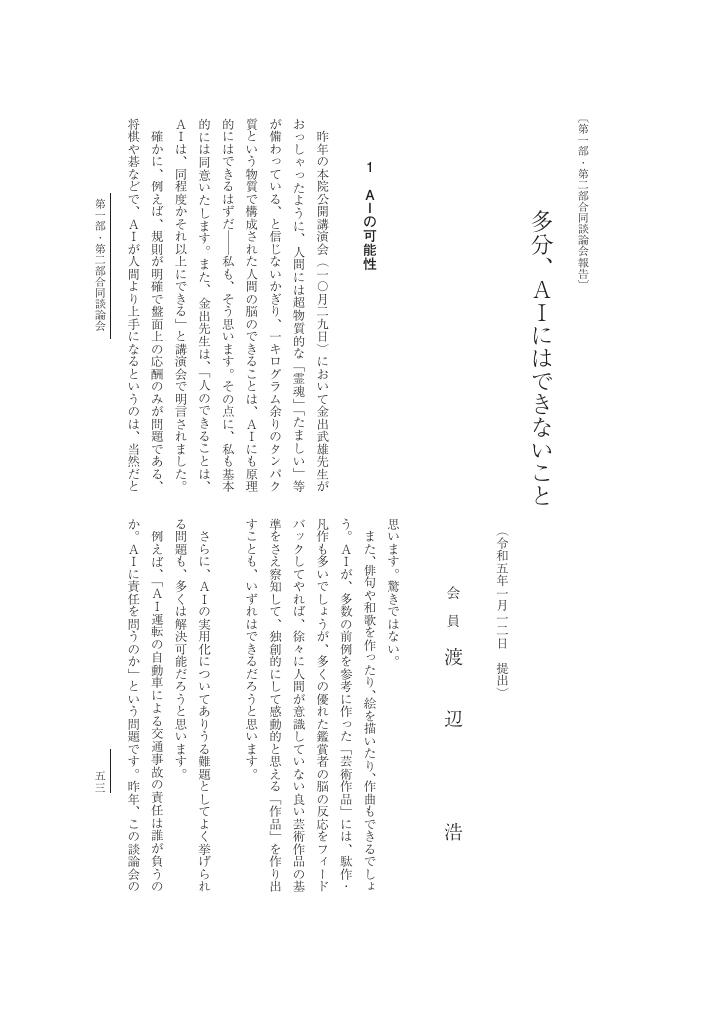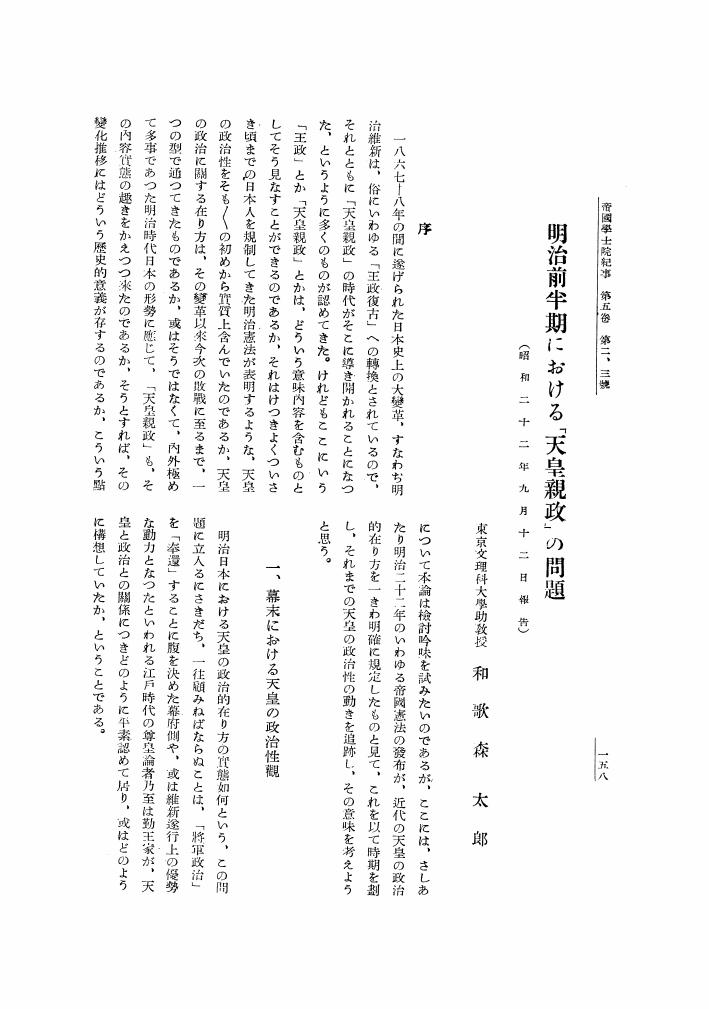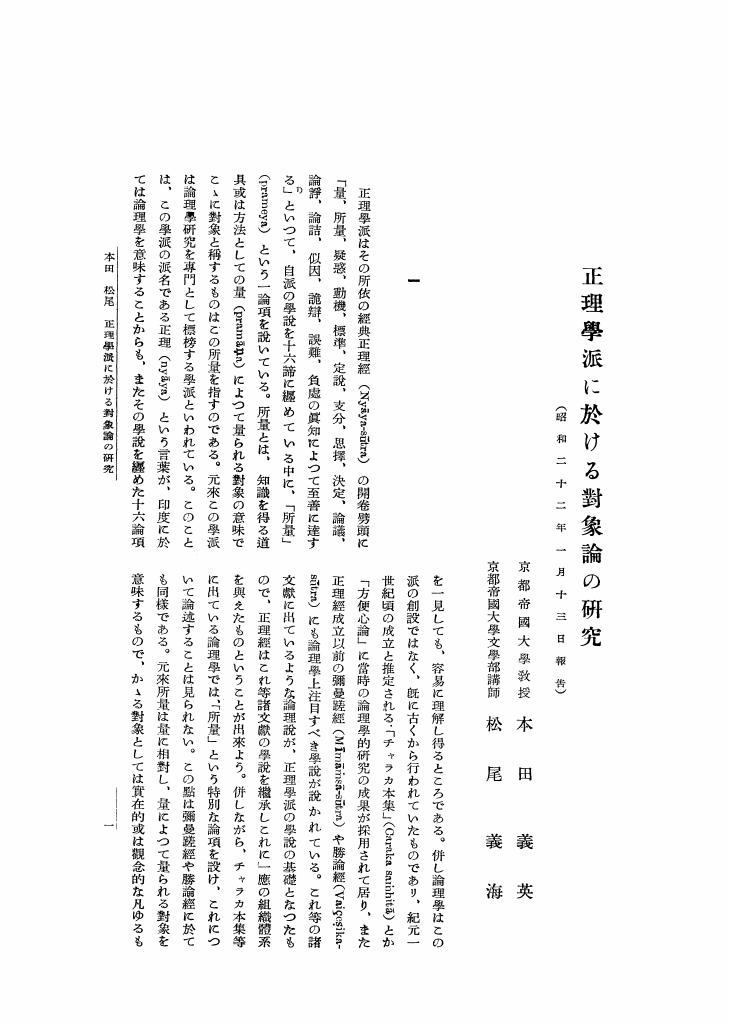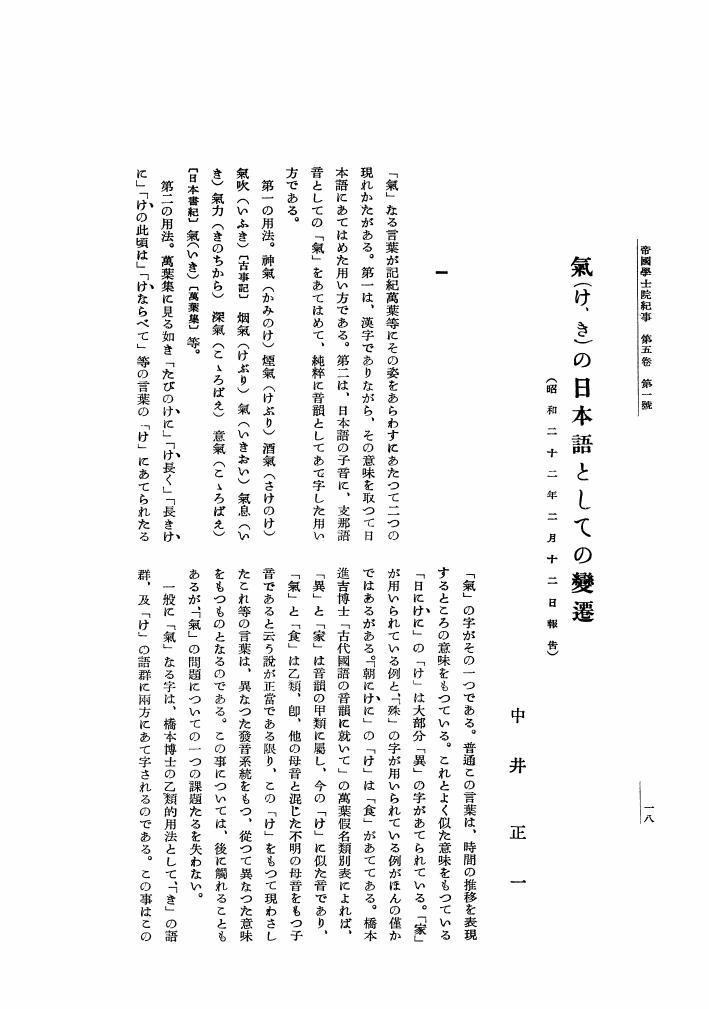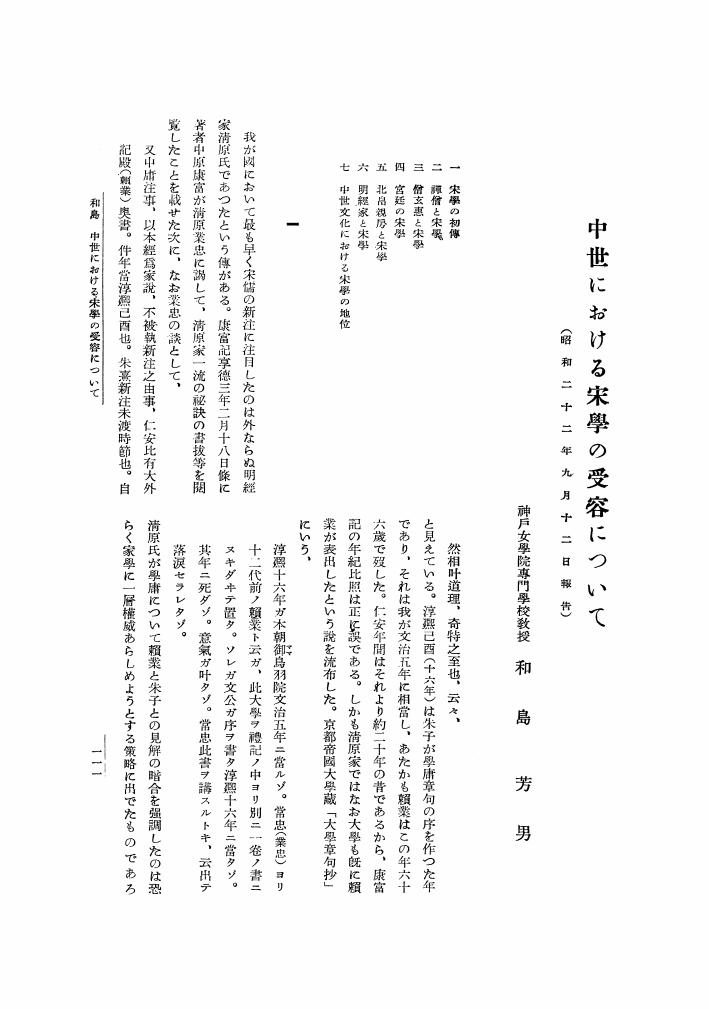2 0 0 0 OA 科学裁判と鑑定
- 著者
- 中野 貞一郎
- 出版者
- 日本学士院
- 雑誌
- 日本學士院紀要 (ISSN:03880036)
- 巻号頁・発行日
- vol.63, no.3, pp.181-196, 2009-03
1 0 0 0 OA 多分、AIにはできないこと
- 著者
- 渡辺 浩
- 出版者
- 日本学士院
- 雑誌
- 日本學士院紀要 (ISSN:03880036)
- 巻号頁・発行日
- vol.78, no.1, pp.53-61, 2023 (Released:2023-11-22)
1 0 0 0 OA 源氏物語の宗教的精神 (昭和四十年十月十二日 提出)
- 著者
- 岡崎 義恵
- 出版者
- 日本学士院
- 雑誌
- 日本學士院紀要 (ISSN:03880036)
- 巻号頁・発行日
- vol.23, no.3, pp.103-123, 1965 (Released:2007-05-30)
1 0 0 0 OA 二つの邪馬台国観 白石説と宣長説 (昭和四十年四月十二日 会員 坂本太郎 紹介)
- 著者
- 宮崎 道生
- 出版者
- 日本学士院
- 雑誌
- 日本學士院紀要 (ISSN:03880036)
- 巻号頁・発行日
- vol.23, no.2, pp.67-89, 1965 (Released:2007-05-30)
- 被引用文献数
- 1
1 0 0 0 OA 天智天皇の立て給いし常の典 (昭和二十五年十二月十四日報告)
- 著者
- 岩橋 小彌太
- 出版者
- 日本学士院
- 雑誌
- 日本學士院紀要 (ISSN:03880036)
- 巻号頁・発行日
- vol.9, no.1, pp.35-40, 1951 (Released:2007-05-30)
1 0 0 0 OA 利益衡量・比例原則の新たな広がりと課題 ──日仏の比較検討
- 著者
- 瀬川 信久
- 出版者
- 日本学士院
- 雑誌
- 日本學士院紀要 (ISSN:03880036)
- 巻号頁・発行日
- vol.76, no.1, pp.55-78, 2021 (Released:2021-11-20)
Introduction Le raisonnement classique du jugement est le syllogisme juridique. Il consiste à appliquer à une situation de fait, une règle de droit, dont la plupart sont établies par l'assemblée. Mais depuis quelques décennies, la mise en balance des intérêts et la proportionnalité repoussent le syllogisme comme forme du jugement. Cette étude a pour but de proposer un aperçu de cette évolution contemporaine en droit français et d'en extraire quelques suggestions pour le droit japonais. Ⅰ. La situation du droit français En France, l'histoire de la balance des intérêts et de la proportionnalité diffère en fonction des divers domaines juridiques. (1) Dans le droit administratif, la proportionnalité a une histoire relativement longue et évolutive. La compétence administrative a été dotée de la justice déléguée au début de la 3e République, et les juges administratifs, ceux du Conseil d'État inclus, disposaient ainsi du pouvoir leur permettant de constater des faits et de les qualifier. D'autre part, comme le code du droit administratif n'existait pas, le juge administratif était obligé de créer les règles jurisprudentielles sous forme de principes généraux du droit.(View PDF for the rest of the abstract.)
1 0 0 0 OA 禅の瞑想意識と脳のデフォルトモードネットワーク
- 著者
- 苧阪 直行
- 出版者
- 日本学士院
- 雑誌
- 日本學士院紀要 (ISSN:03880036)
- 巻号頁・発行日
- vol.77, no.2, pp.117-136, 2023 (Released:2023-02-13)
- 参考文献数
- 50
Meditation in Zen has received much attention in the scientific exploration of consciousness from metacognition and the social brain. Zen meditation provides effective clues to self-knowledge by providing awareness of “present self-being”. Our brains are thought to operate in dynamic equilibrium every day with two broad networks: the working memory network (WMN), which is oriented toward solving real problems (cognitive brain network), and the default mode network (DMN), which wanders in an internal imaginary and a creative world (social brain network). However, how these two cyclical networks operating in seesaw mode relate to meditation is not well understood. In this paper, we used functional magnetic resonance imaging (fMRI) to examine the process of meditation from a cognitive conflict situation in monks who had meditated in Rinzai Zen for over seven years and healthy adults who had not meditated before. The monks were asked to perform a Stroop task as a conflict task in the first half of the study, and were led to meditate in the second half. Behavioral experiments revealed that monks showed excellent performance under the Stroop task with fewer errors and shorter reaction times due to better control of attention, whereas healthy adults showed poor attentional control and were more affected by the conflicts. Two new findings about brain activity were found. First, it was suggested that the two networks were not in an anti-correlated relationship, as is usually claimed, on the time series, but were involved in a mutually cooperative manner. Second, in terms of functional connectivity, the monks' brains showed a strong inhibitory effect under meditation. As a result of years of Zen practice, the monks were found to be able to successfully deal with conflict situations in the DMN of the brain and maintain meditative awareness.
1 0 0 0 OA コメント ──エントロピー概念の展開と自然科学・人文社会科学の交流
- 著者
- 瀬川 信久
- 出版者
- 日本学士院
- 雑誌
- 日本學士院紀要 (ISSN:03880036)
- 巻号頁・発行日
- vol.77, no.1, pp.61-72, 2022 (Released:2022-12-12)
1 0 0 0 OA 英詩の翻訳と詩歌の民族的音律原型 (昭和四十三年一月十二日 提出)
- 著者
- 土居 光知
- 出版者
- 日本学士院
- 雑誌
- 日本學士院紀要 (ISSN:03880036)
- 巻号頁・発行日
- vol.26, no.2, pp.73-89, 1968 (Released:2007-05-30)
1 0 0 0 OA 商業をめぐる社会通念の変化(中国) ─「估客楽」から「商賈指南」へ─
- 著者
- 斯波 義信
- 出版者
- 日本学士院
- 雑誌
- 日本學士院紀要 (ISSN:03880036)
- 巻号頁・発行日
- vol.76, no.3, pp.241-257, 2022 (Released:2022-09-13)
The idea of broadly classifying social classes into the simin “Four Occupations” of the shi (gentry scholars/bureaucrats), nong (peasant farmers), gong (artisans), and shang (merchants) first appeared in China during the spring and autumn periods. Subsequently, the system of state bureaucracy emerged under the unified empire of the Qing and Han dynasties after the Warring States period. In this context, the policy of Fuguo Qiangbing (“enrich the country, strengthen the military”) was adopted, and the Four Occupations came to be ranked in a manner that discriminated between the different occupations; that is, with the merchants and artisans, who were viewed as inferior, being subject to heavier taxes, as well as being conscripted for military service and excluded from becoming bureaucrats. Thus, discrimination became firmly entrenched in the national attitude of the Han dynasty. (View PDF for the rest of the abstract.)
1 0 0 0 OA 明治前半期における「天皇親政」の問題 (昭和二十二年九月十二日報告)
- 著者
- 和歌森 太郎
- 出版者
- 日本学士院
- 雑誌
- 帝國學士院紀事 (ISSN:03879984)
- 巻号頁・発行日
- vol.5, no.2-3, pp.158-176, 1947 (Released:2007-05-30)
1 0 0 0 OA 火山塵の大量を超高度に放射すろ火山に就いて (抄録) (昭和二十二年十月十三日報告)
- 著者
- 今村 明恒
- 出版者
- 日本学士院
- 雑誌
- 帝國學士院紀事 (ISSN:03879984)
- 巻号頁・発行日
- vol.5, no.2-3, pp.177-179, 1947 (Released:2007-05-30)
1 0 0 0 OA 弘化四年の善光寺大地震に隨伴し繼續しれる陸地變形に就て (昭和二十二年七月十二日報告)
- 著者
- 八木 貞助
- 出版者
- 日本学士院
- 雑誌
- 帝國學士院紀事 (ISSN:03879984)
- 巻号頁・発行日
- vol.5, no.2-3, pp.180-186, 1947 (Released:2007-05-30)
1 0 0 0 OA 正理學派に於ける對象論の研究 (昭和二十二年一月十三日報告)
- 著者
- 本田 義英 松尾 義海
- 出版者
- 日本学士院
- 雑誌
- 帝國學士院紀事 (ISSN:03879984)
- 巻号頁・発行日
- vol.5, no.1, pp.1-17, 1947 (Released:2007-05-30)
1 0 0 0 OA 氣 (け、き) の日本語としての變遷 (昭和二十二年二月十二日報告)
- 著者
- 中井 正一
- 出版者
- 日本学士院
- 雑誌
- 帝國學士院紀事 (ISSN:03879984)
- 巻号頁・発行日
- vol.5, no.1, pp.18-36, 1947 (Released:2007-05-30)
1 0 0 0 OA 日本書紀の分註に關する一考察 (昭和二十二年二月十二日報告)
- 著者
- 太田 善麿
- 出版者
- 日本学士院
- 雑誌
- 帝國學士院紀事 (ISSN:03879984)
- 巻号頁・発行日
- vol.5, no.1, pp.37-53, 1947 (Released:2007-05-30)
1 0 0 0 OA 唐船風説書の研究 (昭和二十二年二月十一日報告)
- 著者
- 浦 廉一
- 出版者
- 日本学士院
- 雑誌
- 帝國學士院紀事 (ISSN:03879984)
- 巻号頁・発行日
- vol.5, no.1, pp.54-84, 1947 (Released:2007-05-30)
- 被引用文献数
- 1
1 0 0 0 OA 蘇州語の音節について (昭和二十二年二月十二日報告)
- 著者
- 倉石 武四郎 高田 久彦
- 出版者
- 日本学士院
- 雑誌
- 帝國學士院紀事 (ISSN:03879984)
- 巻号頁・発行日
- vol.5, no.2-3, pp.91-110, 1947 (Released:2007-05-30)
1 0 0 0 OA 中世における宋學の受容について (昭和二十二年九月十二日報告)
- 著者
- 和島 芳男
- 出版者
- 日本学士院
- 雑誌
- 帝國學士院紀事 (ISSN:03879984)
- 巻号頁・発行日
- vol.5, no.2-3, pp.111-136, 1947 (Released:2007-05-30)
1 0 0 0 OA 國分寺創建に於ける道慈の業績 (昭和二十一年三月十二日報告)
- 著者
- 井上 薫
- 出版者
- 日本学士院
- 雑誌
- 帝國學士院紀事 (ISSN:03879984)
- 巻号頁・発行日
- vol.4, no.2, pp.135-172, 1946 (Released:2007-05-30)

